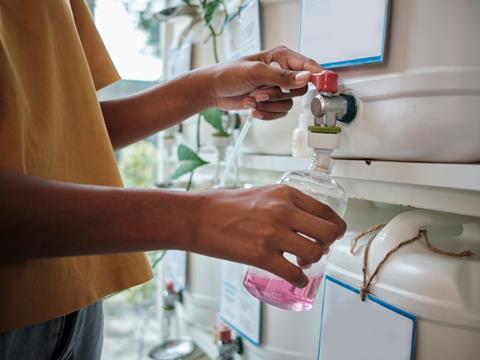
In its new report, Smithers predicts that the global value of reusable and refillable packaging will reach $28.20 billion (€2,645,583,000,000) in 2024 and forecasts the future of the sector in the next five years – including an increase in refill in store and refill/return at home schemes.
Legislative developments like the Packaging and Packaging Waste Regulation are driving an uptake in reusable and refillable alternatives to single-use plastics, Smithers observes. As per the EU’s new rules, all Member States will be required to establish deposit return schemes for plastic and metal drink packaging from 2029.
Furthermore, 2030 will usher in mandatory targets for 10% reuse formats in most beverage segments. As such, ‘significant investment’ is anticipated across the continent; practical exemplars for the contribution of reuse and refill models to wider circular economy goals are expected to arise; and packaging designers, retailers, and logistic operators are facing new challenges in the implementation of reuse solutions.
The Future of Reusable and Refillable Packaging to 2029 provides a detailed analysis of reuse and refill business models, developments in the regulatory landscape, best-use concepts, and the commercial challenges facing converters, retailers, and CPG brands.
The supporting data is broken down by packaging sector, encompassing industrial and transit applications, as well as mature and developing consumer spaces. Furthermore, it separates end-use applications into drinks, industrial and transit, home care, and cosmetics and personal care.
Packaging made of glass, metal, and plastics are observed separately, as are the geographic regions of Western and Eastern Europe; North and South and Central America; Asia-Pacific; the Middle East; and Africa.
A +4.6% compound annual growth rate (CAGR) is forecasted across all segments in the run-up to 2029 – a development expected to yield a market value of $35.36 billion in its final year.
Reuse and refill bottle formats made of glass, metal, and PET, as well as industrial transit formats like drums and rigid intermediate bulk containers (IBCs), are currently popular on the market. Smithers describes them as ‘mature segments’ that will see ‘incremental growth’ throughout the forecast period.
Yet data modelling for new consumer reuse and refill concepts – refill at home, return from home, and refill in store – suggests that sales will increase at a +15.0% CAGR until 2029. This means they will more than double in value and come closer to $1 billion in sales by the end of the decade.
The report notes that the personal care and home cleaning markets are seeing a particular uptake in these models. Major CPG firms are said to be competing with dedicated e-commerce sellers, and an interest in experimenting, as well as efforts by companies to prove their commitment to sustainability targets, are driving the transition.
As a result, packaging designers are now expected to create more durable packages that do not lose their functionality or aesthetics across refill cycles. Metal containers have become increasingly popular for this reason, as well as more resilient plastics, and robust caps and dispensing features.
Smithers lays out four facets of packaging design that, in its view, should be prioritized to ensure that reusable and refillable concepts are effective. One is to maximize consumer convenience; another, related step is to balance price and functionality.
Consumer incentives should be introduced, the report continues, and packaging should be linked seamlessly to integrated logistics and support tools. Smithers notes that CPG brands have been embracing smart technology – in the context of automatic refill deliveries for registered subscribers, for example.
The report is available to buy now at prices of €6,350, £5,475, and $6,750.
Previous Smithers reports have described Europe as a ‘proving ground’ for trialling reuse and refill concepts in the run-up to the Packaging and Packaging Waste Regulation; and suggested that the packaging sector would reach a total value of $1.17 trillion in 2023, adding that flexible plastics and paperboard would become the fastest-growing packaging materials in a five-year time frame.
Another report from Root went on to lay out its views on the most straightforward path to hitting reuse and refill targets. These included a clear roadmap, transparency surrounding environmental benefits, and an understanding of consumers’ needs.
If you liked this story, you might also enjoy:
Report: The ultimate guide to global plastic sustainability regulation
The Brief: Oxo-(bio)degradables: the who, what, and why of breaking down fossil-based plastics
Sustainable Packaging Summit: How Kraft-Heinz uses collaboration to drive innovation
The Brief: Using ocean-bound plastic in packaging – how, why and should we?


















No comments yet